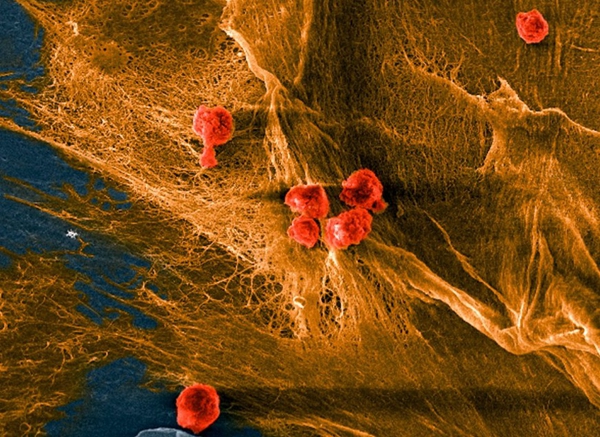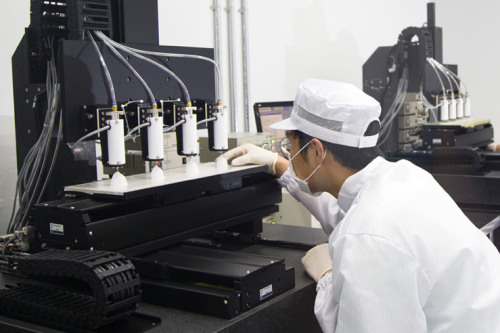3D printing,Composite materials,3D printed bionic,3D printed skin
12 July 2022 - Researchers from Cornell University have created a new biomaterial that can be used to create bionic skin that has a structure similar to human tissue. The bio-hybrid composite developed by the research team has a unique composition of collagen mixed with 'amphiphilic' hydrogel, a soft and biocompatible material that is flexible enough to withstand constant deformation. While the scientists' development project is still ongoing, they say this bio-ink could one day be used as the basis for 3D printing patient cell scaffolds to effectively heal wounds.
Nikolaos Bouklas, one of the study's co-lead authors, said: "Our ultimate goal is to create a material that can be used in regenerative medicine, such as a piece of scaffolding that can withstand part of the original load until the tissue is completely regenerated. With this material, you can 3D print a porous scaffold with cells that can eventually form the actual tissue around the scaffold."

Microscopic image of the ΔBiohybrid composite, with cells (red) seeded on a fibrous structure of collagen (yellow). Image from Cornell University.
Combining natural and synthetic materials
Given the nature of the body's constant movement, our tissues need to be both soft enough to bend on command and strong enough to withstand constant loading. When these cells become worn out or damaged, hydrogels and synthetic materials could serve as replacements, but neither has the proper biological and mechanical properties to do so at the same time, the Cornell team says. The scientists believe that synthetic plastics often lack the ability to support and maintain living cells, making it difficult to generate microscopic structural tissues that can function. Meanwhile, when it comes to natural polymers such as collagen, fibrin or hyaluronic acid, researchers believe that although they are able to replicate the biocompatibility of living tissue, they tend to be more fragile.
In order to create a bio-ink that is flexible and cell-friendly enough to produce near-real artificial skin, the team turned their attention to 'amphoteric hydrogels'. Specifically, the scientists found that mixing collagen with this material, which contains both positively and negatively charged molecular groups, allowed it to withstand multiple impacts while supporting cell growth.
Lawrence Bonassar, one of the study's other co-lead authors, explains, "These charge groups interact with the negatively and positively charged groups in the collagen, and this interaction allows the material to dissipate energy and achieve high levels of toughness."

△Lawrence Bonassar, Professor at Cornell University. photo from Cornell University.
Laying the groundwork for a more realistic artificial skin?
Interestingly, in their paper, the researchers say their recipe for bio-hybrid composites requires only "simple mixing" as their collagen self-assembles into a fibrous network, which in turn is ionically connected to the surrounding hydrogel. According to Bouklas, this generates the same network of collagen interconnections seen in natural cartilage, which would otherwise be very difficult to produce.
The team tested the material and showed that the addition of collagen increased its modulus of elasticity by 40 per cent compared to the untreated polymer matrix. They also found that combining collagen with hydrogel enabled the material to absorb 11 times more energy before cracking, while giving it similar properties to tissues such as articular cartilage.
In terms of biocompatibility, the scientists found that their collagen polymer was more than 100 times more capable of supporting cell growth, and it showed over 90 per cent cell viability. The researchers say they intend to continue to study the biosynthetic process behind the material, and they have now begun testing its feasibility for 3D printing of tissues.

△HK inno.N has partnered with T&RBiofab to create human skin using its 3D bioprinting technology. Image from T&RBiofab.
The potential of 3D bioprinted tissues
Although 3D printed human tissues are often still in the laboratory testing phase, the technology behind them has developed by leaps and bounds in the last few years alone. in January 2022, researchers at the University of Birmingham and the University of Huddersfield revealed that they had developed a way to treat deep wounds with bioprinted skin. Similarly, late last year, the NOVOPLASM consortium announced the creation of the "world's first" 3D printed immune skin model. Developed using cold plasma technology, the model could be used in the future to treat conditions such as infected burns and irritated skin grafts.
In addition to wound healing applications, 3D printing is also being used to create tissue for skin care product development. For example, HK inno.N and T&R Biofab have collaborated with the aim of developing 3D bioprinted tissues for drug testing, which could be used as an alternative to testing on animals.
The researchers' findings are detailed in their paper entitled " Simple synthesisof soft, tough, and cytocompatible biohybrid composites/ Simple synthesis of soft, tough and cytocompatible biohybrid composites", which was written by Cameron Darkes- Burkey, Xiao Liu,Leigh Slyker, Jason Mulderrig, Wenyang Pan, Emmanuel P. Giannelis, Robert F. Shepherd, Lawrence J. Bonassar and Nikolaos Bouklas.

Link to related paper: https://www.pnas.org/doi/abs/10.1073/pnas.2116675119







